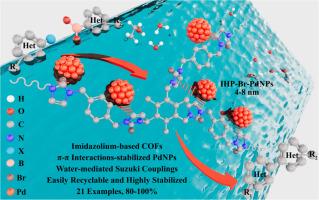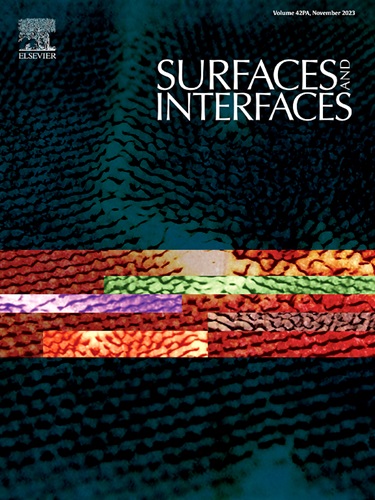提高π-π相互作用稳定的 PdNPs 在水介导的芳基氯化物铃木偶联反应中的催化活性
IF 5.7
2区 材料科学
Q2 CHEMISTRY, PHYSICAL
引用次数: 0
摘要
利用独特的相互作用来提高支撑金属催化剂的催化性能是催化剂设计中的一项重要策略,尽管这也是一项巨大的挑战。本研究介绍了一种独创的方法,即利用 π-π 相互作用来稳定钯纳米粒子(PdNPs)与 2Br 取代的咪唑基共价有机框架(COF,IHP-Br-PdNPs),从而在环境条件下高效地进行水介导的铃木反应,该反应涉及失活的芳基氯化物和芳基硼酸。通过采用傅立叶变换红外光谱(FT-IR)、交叉偏振魔角旋转碳-13 核磁共振(CP/MAS 13C NMR)、扫描电子显微镜(SEM)、透射电子显微镜(TEM)等技术进行广泛的结构表征、我们利用高角度环形暗场扫描透射电子显微镜 (HAADF-STEM)、X 射线衍射 (XRD)、热重分析 (TGA)、N2 吸附和 X 射线光电子能谱 (XPS),证明获得了高度稳定和分散良好的 PdNPs 固定化。所设计的 IHP-Br-PdNPs 在环境空气中的稳定性可长达 36 个月,并可有效回收。经过 9 次催化循环后,催化性能没有明显下降,而且在整个反应过程中,PdNPs 的粒径始终保持在约 4-8 nm。稳定剂与金属之间的配位模式,特别是 2Br 取代的咪唑鎓分子与钯金属表面之间的 π-π 相互作用,在稳定各种活性物种和促进不同催化途径方面发挥了关键作用。这项研究为π-π相互作用支撑金属催化剂的开发提供了宝贵的见解,这些催化剂可在先进的水介导合成应用中提高稳定性和催化活性。本文章由计算机程序翻译,如有差异,请以英文原文为准。

Boosting catalytic activity of π-π interactions-stabilized PdNPs for water-mediated Suzuki couplings of aryl chlorides
Utilizing unique interactions to enhance the catalytic performance of supported metal catalysts is a crucial strategy in catalyst design, albeit one that presents a significant challenge. This study introduces an original approach involving the use of π-π interactions to stabilize palladium nanoparticles (PdNPs) with a 2Br-substituted imidazolium-based covalent organic framework (COF, IHP-Br-PdNPs) for efficient water-mediated Suzuki reactions involving deactivated aryl chlorides and arylboronic acids at ambient conditions. Through extensive structural characterization employing techniques including Fourier transform infrared spectroscopy (FT-IR), cross-polarization magic angle spinning carbon-13 nuclear magnetic resonance (CP/MAS 13C NMR), scanning electron microscopy (SEM), transmission electron microscopy (TEM), high-angle annular dark field scanning transmission electron microscopy (HAADF-STEM), X-ray diffraction (XRD), thermogravimetric analysis (TGA), N2 adsorption, and X-ray photoelectron spectroscopy (XPS), we demonstrate the immobilization of highly stable and well-dispersed PdNPs was obtained. The designed IHP-Br-PdNPs demonstrate stability for up to 36 months in ambient air and can be efficiently recycled. After 9 catalytic cycles, there was no significant decline in catalytic performance, and the particle size of PdNPs remained constant at approximately 4–8 nm throughout the reactions. The coordination mode between the stabilizer and metal, specifically the π-π interaction between the 2Br-substituted imidazolium moiety and the Pd metal surface, plays a key role in stabilizing various active species and facilitating distinct catalytic pathways. This study provides valuable insights into the development of π-π interactions supported metal catalysts, which enhance stability and catalytic activity in advanced water-mediated synthesis applications.
求助全文
通过发布文献求助,成功后即可免费获取论文全文。
去求助
来源期刊

Surfaces and Interfaces
Chemistry-General Chemistry
CiteScore
8.50
自引率
6.50%
发文量
753
审稿时长
35 days
期刊介绍:
The aim of the journal is to provide a respectful outlet for ''sound science'' papers in all research areas on surfaces and interfaces. We define sound science papers as papers that describe new and well-executed research, but that do not necessarily provide brand new insights or are merely a description of research results.
Surfaces and Interfaces publishes research papers in all fields of surface science which may not always find the right home on first submission to our Elsevier sister journals (Applied Surface, Surface and Coatings Technology, Thin Solid Films)
 求助内容:
求助内容: 应助结果提醒方式:
应助结果提醒方式:


